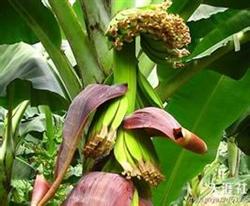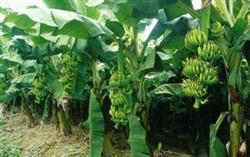High-yield and High-benefit cultivation techniques of Banana

Banana is an important tropical and subtropical fruit. In order to achieve high quality, high yield and high benefit of banana production, we must do a good job in banana garden selection, adopt improved varieties and strong seedlings, timely planting, reasonable close planting, do a good job in fertilizer and water management, timely removal of buds, scientific bud breaking and bagging, and do a good job in comprehensive prevention and control of diseases and insect pests. do a good job of wind and cold prevention and other work. 1. Banana orchard selection: banana root system is a strong fleshy root system, horizontal root distribution in the surface soil layer of about 15 cm, vertical root depth of up to 1.4 meters, banana leaves are large, transpiration is also large, sensitive to water requirements. Therefore, the ideal banana orchard should choose the place with loose soil, deep and fertile soil, pH between 5.5 and 6.5, no toxic substances, low groundwater level and convenient drainage and irrigation. two。 Selection of improved varieties: the selection of excellent varieties is one of the keys to high quality, high yield and high benefit in banana production. Therefore, varieties with high quality and high yield, strong adaptability and strong wind resistance must be selected. After planting practice in recent years, the better varieties are Guangdong banana No. 2, Brazil No. 3 and so on. 3. Timely planting: due to the reform of the farming system and the improvement of cultivation techniques, bananas can be planted all the year round in our province, but there are generally more planting in spring and autumn. Spring planting is planted from February to April, budding from September to October of that year, and out-of-season bananas are harvested from February to May of the following year, the price is generally higher; autumn planting is planted from August to September, budding is from May to July of the following year, and plantain is being harvested from August to October, which has good quality and high yield and good benefit. 4. Reasonable close planting: the number of plants per unit area is small, although the ear is large, the fruit weight, but the total yield is not high; similarly, too many plants, resulting in mutual shade, serious diseases and insect pests, low yield per plant, the total yield is not high. Therefore, the planting density should be determined according to the variety, soil quality, topography and budding mode. Generally, the width of the border is 2 to 2.5 meters, the width of the ditch is 0.8 meters to 1 meter, double rows are planted, the plant spacing is 2 meters, and it is suitable to plant 110 plants per mu. 5. Scientific fertilization: banana is a typical potassium-loving crop, which has the highest demand for potassium fertilizer, medium nitrogen fertilizer and less phosphorus fertilizer. Generally, the formula fertilization with the ratio of nitrogen, phosphorus and potassium is 1: 0.4 and 1.5: 2 is better. Taking the tissue culture seedlings of spring planting banana as an example, the fertilization principle is that the early stage should be applied frequently and thinly, the middle and later stages of vegetative growth and flower bud differentiation should be re-applied, the early stage is mainly nitrogen fertilizer, combined with potassium and phosphorus fertilizer, and in the middle and later stage, potash fertilizer is the main fertilizer, combined with nitrogen and phosphorus fertilizer. Fertilization began when new leaves grew 10-15 days after tissue culture seedlings were planted. There were 16-18 times of fertilization per plantain, including 11 times of thin application and 5 times of re-application. The total amount of fertilizer applied per plant is as follows: urea 1: 1.4 kg, calcium superphosphate 0.4 kg, superphosphate 0.5 kg, potassium chloride 0.8 kg, peanut bran 0.75 kg, and banana special fertilizer 3 kg 3.5 kg. The main method of fertilization is leaching application, supplemented by acupoint application. 6. Rational drainage and irrigation: bananas are afraid of both waterlogging and drought. Therefore, the early seedling should be watered and moisturized, the middle growth should be frequently irrigated with "horse racing water", and the later root and leaf protection should keep the soil moist. In the rainy season, attention should be paid to the timely elimination of waterlogging to prevent banana plantations from being soaked. 7. Timely removal of buds and leaving buds: bananas grow to about 1 meter high to grow sucking buds, each plant can generally pull out 4-6 sucking buds. The sucking bud and the mother plant are an organic whole, and the growth of the absorbing bud and the flowering of the mother plant will affect each other sooner or later, so keeping buds should be based on the principle that it does not hinder the normal growth of the mother plant, except that one sucking bud is left as the next fruiting mother plant. the rest of the sucking buds were cut off with a shovel or a special sharp knife when the bud was 15cm long. 8. Scientific bud breaking and bagging: buds are broken at the end of the female flower bloom, and the comb number of the ear is determined according to the plant growth. Generally, 7-8 combs are left per ear, and the last comb is separated by 1-2 combs. Cut off the fruit axis with a sharp knife (usually the bud is cut off and temporarily hung on the ear, using its own weight to keep the lower part of the ear from bending up), and then remove the inflorescence from the excess comb. There is only one finger left in the last comb. In this way, the quality is not affected by leaving more fruit combs, and the growth of tail combs is not affected by cutting the mouth. Buds should be cut off in the afternoon on a sunny day. Bagging was carried out about 2 days after bud breaking, and carbendazim and Lesbon were sprayed once before bagging. Fruit bagging can improve the control effect of diseases and insect pests, reduce fruit mechanical damage, improve fruit growth environment, and improve fruit quality and yield. 9. Integrated control of diseases and insect pests: banana common diseases are bunchy top disease, mosaic heart rot, leaf spot, anthracnose and scab, pests are leaf rollers, aphids and so on. In order to prevent bunchy top disease and mosaic heart rot, 1000 times liquid or 40% dimethoate solution can be sprayed from March to April to control aphids, eliminate the source of spreading insects, and dig up and bury or burn the diseased plants in time. Leaf spot disease can be controlled by spraying 1000 times of enemy demulsifiable oil once a month during the peak period from June to September. Scab can be controlled by spraying young fruits with 1000 times of carbendazim after the female flowers bloom. Anthracnose can be controlled with 75% chlorothalonil 800 times. Leaf curlers can be sprayed with 1000 times of 80% dichlorvos EC. 10. Wind and cold: June to September is the coastal area typhoon-prone season, bananas are not wind-resistant crops, therefore, we must do a good job of wind prevention. In June, each banana is supported by wooden strips or bamboo poles. Bananas are native to tropical and subtropical regions, and the whole growth period requires high temperature and humidity, and avoid low temperature. Therefore, it is necessary to strengthen the overwintering management of bananas and cover the ears of bananas with plastic bags before the cold wave comes. For unbudding bananas, the leaves at the top of the banana plant can be tied into bundles to prevent cold injury.
- Prev

Mechanization Technology of Banana production
(1) ① management of flowering bananas if leaves or petioles hinder the emergence of buds, bananas should be removed or cut off. Such as the extraction position is sometimes just above the petiole, blocked by the petiole and can not gradually droop, such as let it go down, due to the increase in the weight of the bud, and break the petiole, bud.
- Next

Requirements of banana on soil conditions
Cultivation techniques Banana is a large perennial herbaceous monocotyledonous plant, its underground stem is a thick bulb, from which roots, stems, leaves, flowers, fruits and sucking buds (for reproduction) grow. Banana likes high temperature and high humidity. The growth temperature is usually 20: 35 ℃, the optimum temperature is 24: 32 ℃, and the critical temperature of each organ is 10: 12 ℃.
Related
- Moge, come on! The staff of the peasant association in the producing area of cantaloupe were frightened when the crowd gathered.
- Causes and Solutions of low Fruit setting rate of Apple
- Symptoms and control measures of passion fruit virus disease
- Fruit growing lesson: how do apple orchards keep high yields?
- Can you build orchards in the mountains? What are the pros and cons?
- How to manage the coloring period of Crisson grape?
- This paper introduces the processing technology of two kinds of fig products.
- How much is a month for retired teachers in rural areas by 2020?
- How can strawberry planting increase sugar content? We should pay attention to management in many aspects.
- What are the cultivation techniques on how to improve the yield of golden fruit?

